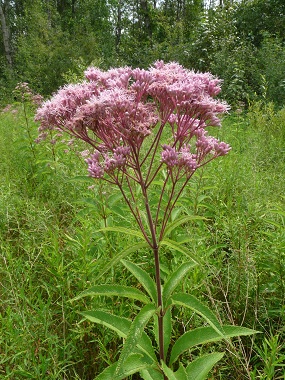



To support our efforts please browse our store (books with health benefits, etc.).
Joe Pye weed is an amazing wild edible plant that is an herb, a wildflower, a butterfly plant and looks great in cultivated flower beds. The origin of the common name of this plant is uncertain however the most prevalent theory holds that it refers to a Native American named Joe Pye (Jopi), who used this perennial plant to cure typhus in the 1800’s. This is a hardy perennial that blooms when many other plants are finished and it lasts until the first hard frost. When made into a tea, it has many health benefits. Its other name, gravel root was listed in the U.S. Pharmacopoeia from 1820 to 1842.
Distinguishing Features
Joe Pye weed boasts beautiful plumes of lightly-scented pink (and sometimes purplish) flowers at the ends of the stems from about July to late fall depending on location.
Flowers
The flower heads are generally large, domed or flat-topped clusters of small pinkish tubular disk flowers. They bloom from July to September.
 Fields
of Nutrition has medicinal benefits and vitamin/mineral content of Joe Pye Weed.
Fields
of Nutrition has medicinal benefits and vitamin/mineral content of Joe Pye Weed.
Leaves
Joe Pye weed leaves are whorled and can grow as long as 25 cm. They can grow to be as wide as 10 cm. There are usually four to seven leaves to a node and each leaf is lanceolate to elliptic, toothed, rounded and somewhat irregular. The surface of the leaf is generally rough.
Height
Can reach 3 metres high in the southern U.S. but in most areas of Canada they average about 1 metre.
Habitat
This plant is found in moist woods, fields and marshes, damp thickets, and along streams.
Edible Parts
The entire plant can be used including the root. The leaves and stems can be harvested in the summer before the flower buds open and can be dried and stored for later use. The roots are harvested in the autumn. Fresh flowers can be used to make an herbal tea.
Other Name
Gravel Root.
Similar Plants
Boneset.
Winter Survival Food Handbook

PDF Plant Magazines
Types of Wild Food
Geographic Zones Seasons
Disclaimer
EdibleWildFood.com is informational in nature. While we strive to be 100% accurate, it is solely up to the reader to ensure proper plant identification. Some wild plants are poisonous or can have serious adverse health effects.
We are not health professionals, medical doctors, nor are we nutritionists. It is up to the reader to verify nutritional information and health benefits with qualified professionals for all edible plants listed in this web site. Please click here for more information.
Why Edible Wild Food?
- Food costs are rising
- Free, wild food is readily abundant
- Wild food adds nutrition to your diet
- Wild food can help treat various medical conditions







